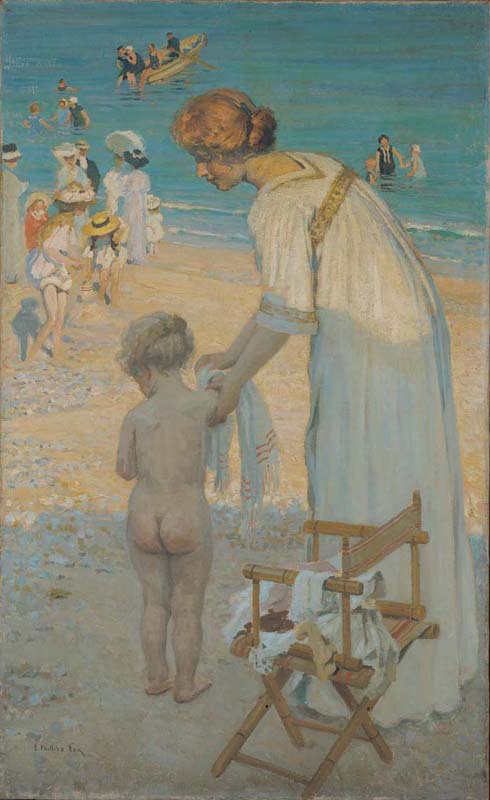We acknowledge the Traditional Owners of the land on which the Queensland Art Gallery | Gallery of Modern Art stands and recognise the creative contribution First Australians make to the art and culture of this country.

E Phillips Fox / Australia/France 1865–1915 / Bathing hour (L’heure du bain) c.1909 / Oil on canvas / 183.5 x 113.3cm / Purchased 1946 / Collection: Queensland Art Gallery | Gallery of Modern Art
E Phillips FoxBathing hour (L’heure du bain) c.1909
On Display: QAG, Gallery 11
Bathing hour (L’heure du bain) c.1909 is thought to depict a beach on France’s Channel Coast, which, in the early twentieth century, was frequented by the upper middle class.
Bathing was not yet common and, while it was unusual for a female child to appear naked in polite society, it was equally unusual for her to be tended to by her mother rather than a nanny. By contrasting the girl’s nakedness and the mother’s flowing robes with the more restrictive costumes of the women in the background, Fox may be commenting on the relaxation of social customs that was occurring in Europe at the time.
The painting is one of two versions of the same subject. The earlier of the two, entitled The bathing hour 1909, is in the collection of the Castlemaine Art Gallery & Historical Museum, Victoria. The immediacy of the brushwork and the realistic shadows that characterise the earlier version indicate that it was probably painted en plein air, directly from the subject. This later version, a more formal painting, in which the artist has eliminated some of the shadowing of the subject, was probably painted entirely in the artist’s studio.
Emanuel Phillips Fox was born in Fitzroy, Melbourne. He trained at the National Gallery of Victoria Art School from 1881 to 1886 and travelled to Paris the following year to study. Over the next five years, he joined artist colonies in northern France and in Cornwall, England, and exhibited in Paris.
On his return to Australia in 1892, his achievements were recognised with a solo exhibition of his work at the National Gallery of Victoria. In 1893 he and George Tucker established the Melbourne Art School.
In 1902, Fox returned to Europe to paint Landing of Captain Cook at Botany Bay 1770, a work commissioned by the trustees of the National Gallery of Victoria. He married English artist Ethel Carrick in 1905, and the couple based themselves in Paris while Fox made a series of painting trips through France, Italy and Spain. They returned to Australia in 1913 where Fox undertook a series of portrait commissions of eminent Australians.
Discussion Questions
1. In this painting Fox has portrayed a mother and daughter at the beach in France. What are some similarities between this scene from a long time ago and a scene at one of Australia’s local beaches today? What are some of the differences?
2. The shadowing in this painting is a visual device. Can you explain its purpose?
Activities
1. Create a series of drawings or paintings that show the types of activities you would do on holiday or on the weekends. Display the images with accompanying labels. Each label should include a title, date, artist and brief description.
2. Fox has created the sense of a warm summer’s afternoon by exploiting the complementary colour scheme of blue and orange. The warm tones of the sand and the mother’s hair contrast with the cool green-blue sea. Explore the shadows and light of an Australian beach scene by taking your own photos. Use your own complementary colour scheme (refer to a colour wheel) to develop your photographic studies into a painting. Mix the complementary colours together to create the shadows.